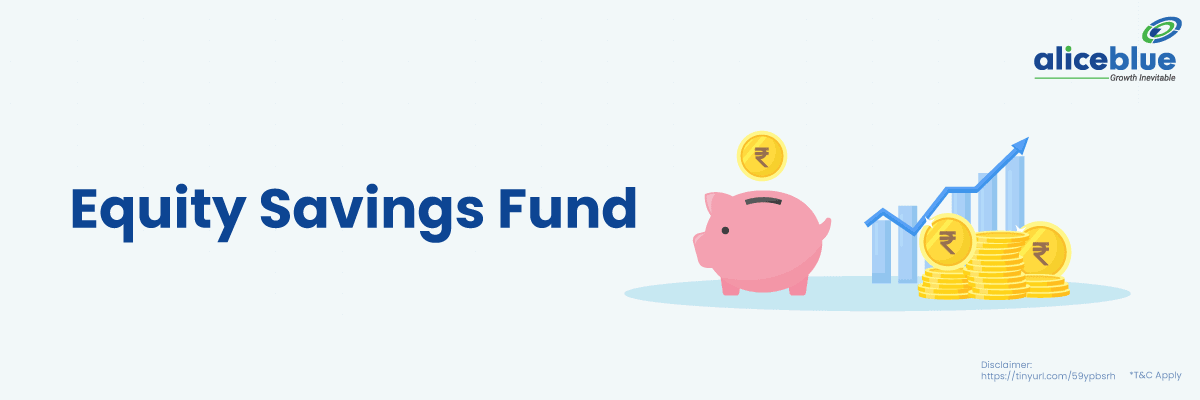Equity Savings Funds are a type of investment that split your money between stocks, safe fixed deposit-like options, and risk-free tools. They can give you higher returns compared to regular bank fixed deposits of the same time frame.
The table below shows the Best Equity Savings Fund based on AUM, NAV and minimum SIP.
| Name | AUM | NAV | Minimum SIP |
| ICICI Pru Equity Savings Fund | 6461.14 | 20.67 | 100.00 |
| HDFC Equity Savings Fund | 2978.20 | 60.51 | 100.00 |
| Kotak Equity Savings Fund | 2935.57 | 22.92 | 100.00 |
| SBI Equity Savings Fund | 2447.09 | 21.84 | 5000.00 |
| Axis Equity Saver Fund | 888.02 | 20.30 | 100.00 |
| Mirae Asset Equity Savings Fund | 690.23 | 17.41 | 100.00 |
| DSP Equity Savings Fund | 661.19 | 19.87 | 100.00 |
| Sundaram Equity Savings Fund | 587.60 | 64.92 | 100.00 |
| Aditya Birla SL Equity Savings Fund | 465.42 | 20.69 | 100.00 |
| Mahindra Manulife Equity Savings Fund | 404.98 | 19.68 | 100.00 |
Content:
- Best Equity Savings Fund
- Equity Savings Mutual Fund
- Top Equity Savings Fund
- Best Equity Savings Fund
- Equity Savings Fund
- Equity Savings Fund – FAQs
- Introduction to Equity Savings Fund
Best Equity Savings Fund
The table below shows Best Equity Savings Fund based on lowest to highest expense ratio.
| Name | Expense Ratio |
| Franklin India Equity Savings Fund | 0.31 |
| Bandhan Equity Savings Fund | 0.37 |
| Tata Equity Savings Fund | 0.41 |
| Mirae Asset Equity Savings Fund | 0.42 |
| ICICI Pru Equity Savings Fund | 0.45 |
| PGIM India Equity Savings Fund | 0.51 |
| Aditya Birla SL Equity Savings Fund | 0.55 |
| Edelweiss Equity Savings Fund | 0.60 |
| HSBC Equity Savings Fund | 0.60 |
| DSP Equity Savings Fund | 0.61 |
Equity Savings Mutual Fund
The table below shows Equity Savings Mutual Fund In India based on Highest 3Y CAGR.
| Name | CAGR 3Y |
| Sundaram Equity Savings Fund | 15.99 |
| HDFC Equity Savings Fund | 14.99 |
| Mahindra Manulife Equity Savings Fund | 14.90 |
| UTI Equity Savings Fund | 14.25 |
| Mirae Asset Equity Savings Fund | 13.88 |
| HSBC Equity Savings Fund | 13.85 |
| SBI Equity Savings Fund | 13.68 |
| Franklin India Equity Savings Fund | 12.49 |
| Kotak Equity Savings Fund | 12.43 |
| DSP Equity Savings Fund | 12.38 |
Top Equity Savings Fund
The table below shows Top Equity Savings Fund based on exit load i.e. the fee that the AMC charges investors when exiting or redeeming their fund units.
| Name | AMC | Exit Load |
| Sundaram Equity Savings Fund | Sundaram Asset Management Company Limited | 0.00 |
| Franklin India Equity Savings Fund | Franklin Templeton Asset Management (India) Private Limited | 0.00 |
| DSP Equity Savings Fund | DSP Investment Managers Private Limited | 0.00 |
| PGIM India Equity Savings Fund | PGIM India Asset Management Private Limited | 0.00 |
| SBI Equity Savings Fund | SBI Funds Management Limited | 0.10 |
| Edelweiss Equity Savings Fund | Edelweiss Asset Management Limited | 0.25 |
| Aditya Birla SL Equity Savings Fund | Aditya Birla Sun Life AMC Limited | 0.25 |
| Tata Equity Savings Fund | Tata Asset Management Private Limited | 0.25 |
| ICICI Pru Equity Savings Fund | ICICI Prudential Asset Management Company Limited | 0.25 |
| Bandhan Equity Savings Fund | Bandhan AMC Limited | 0.25 |
Best Equity Savings Fund
The table below shows Best Equity Savings Fund based on Absolute Return 1 Year and AMC.
| Name | AMC | Absolute Returns – 1Y |
| UTI Equity Savings Fund | UTI Asset Management Company Private Limited | 13.93 |
| SBI Equity Savings Fund | SBI Funds Management Limited | 13.53 |
| Sundaram Equity Savings Fund | Sundaram Asset Management Company Limited | 13.40 |
| Kotak Equity Savings Fund | Kotak Mahindra Asset Management Company Limited | 12.79 |
| HSBC Equity Savings Fund | HSBC Global Asset Management (India) Private Limited | 12.56 |
| Nippon India Equity Savings Fund | Nippon Life India Asset Management Limited | 12.25 |
| Mirae Asset Equity Savings Fund | Mirae Asset Investment Managers (India) Private Limited | 12.04 |
| Mahindra Manulife Equity Savings Fund | Mahindra Manulife Investment Management Private Limited | 12.00 |
| Invesco India Equity Savings Fund | Invesco Asset Management Company Pvt Ltd. | 11.31 |
| ICICI Pru Equity Savings Fund | ICICI Prudential Asset Management Company Limited | 11.13 |
Equity Savings Fund
The table below shows Equity Savings Fund based on Highest 5Y CAGR.
| Name | CAGR 5Y |
| Sundaram Equity Savings Fund | 11.89 |
| Mahindra Manulife Equity Savings Fund | 11.69 |
| SBI Equity Savings Fund | 10.33 |
| Kotak Equity Savings Fund | 10.04 |
| UTI Equity Savings Fund | 9.90 |
| HDFC Equity Savings Fund | 9.86 |
| Edelweiss Equity Savings Fund | 9.82 |
| Axis Equity Saver Fund | 9.49 |
| HSBC Equity Savings Fund | 9.44 |
| DSP Equity Savings Fund | 9.22 |
Looking for the Best Stocks in different sectors? Check out the following articles:
Equity Savings Fund – FAQs
What are the Best Equity Savings Fund?
Best Equity Savings Fund #1:ICICI Pru Equity Savings Fund.
Best Equity Savings Fund #2:HDFC Equity Savings Fund.
Best Equity Savings Fund #3:Kotak Equity Savings Fund.
Best Equity Savings Fund #4:SBI Equity Savings Fund.
Best Equity Savings Fund #5:Axis Equity Saver Fund.
These funds are listed based on Highest AUM.
What is an equity saving fund?
Equity Savings Schemes allocate 30-35% to stocks for growth and invest the rest in debt for stability, with potential returns from arbitrage. Aiming for balance, ESS combines equity gains, fixed-income stability, and arbitrage tactics.
Are equity saving funds good?
Equity savings funds offer a balanced mix of equity, debt, and arbitrage components, appealing to those with moderate risk tolerance. Combining growth potential with stability, these funds suit investors seeking balance. Evaluate alignment with personal financial goals and risk tolerance before investing
Why equity is better than FD?
Equity investments are favored over FDs due to their potential for higher returns, beating inflation and enabling wealth growth. Unlike fixed-rate FDs, equities allow participation in company profits, potentially yielding significant gains. However, they entail higher volatility, suiting long-term investors with high risk tolerance
Are equity savings funds safe?
Equity savings funds, despite their balanced approach with equity, debt, and arbitrage components, entail inherent market risks, especially in equities. Safety relies on asset allocation and strategy, emphasizing the need for investors to evaluate risk tolerance and goals before including these funds in their portfolio.
What are the Top Equity Savings Funds?
Top Equity Savings Funds #1:UTI Equity Savings Fund
Top Equity Savings Funds #2:SBI Equity Savings Fund
Top Equity Savings Funds #3:Sundaram Equity Savings Fund
Top Equity Savings Funds #4:Kotak Equity Savings Fund
Top Equity Savings Funds #5:HSBC Equity Savings Fund
These funds are listed based on Highest Absolute Returns of 1 tear.
Introduction to Equity Savings Fund
Equity Savings Fund – AUM, NAV
ICICI Pru Equity Savings Fund
ICICI Prudential Equity Savings Fund Direct-Growth is an Equity Savings mutual fund scheme offered by Icici Prudential Mutual Fund. This fund has a track record of 8 years and 10 months. Currently, ICICI Prudential Equity Savings Fund Direct-Growth manages assets worth ₹6461.14 Crores.
HDFC Equity Savings Fund
HDFC Retirement Savings Fund – Hybrid Equity Plan Direct-Growth is a mutual fund scheme specializing in Retirement Solutions, offered by HDFC Mutual Fund. This fund has a history of 7 years and 7 months. Currently, HDFC Retirement Savings Fund – Hybrid Equity Plan Direct-Growth manages assets totaling ₹2978.20 Crores.
Kotak Equity Savings Fund
Kotak Equity Savings Fund Direct-Growth is an Equity Savings mutual fund scheme provided by Kotak Mahindra Mutual Fund. This fund has a history of 9 years. As of now, Kotak Equity Savings Fund Direct-Growth manages assets amounting to ₹2935.57 Crores.
Best Equity Savings Fund – Expense Ratio
Franklin India Equity Savings Fund
The Franklin India Equity Savings Fund Direct – Growth scheme demonstrates a consistent return performance that is in line with the majority of funds in its category. However, its ability to mitigate losses in a declining market is considered below average. It’s noteworthy that the fund maintains a relatively low expense ratio of 0.31%, which is lower than the fees charged by most other Equity Savings funds.
Bandhan Equity Savings Fund
Bandhan Equity Savings Fund Direct-Growth is an Equity Savings mutual fund scheme offered by Bandhan Mutual Fund. This fund has a track record of 10 years and 8 months. Notably, the fund maintains a relatively low expense ratio of 0.37%, which is below the typical fees charged by most other Equity Savings funds.
Tata Equity Savings Fund
The Tata Equity Savings Fund Direct-Growth scheme demonstrates a consistent return performance that is in line with most funds in its category. Additionally, its ability to manage losses in a declining market is considered to be at an average level. The fund maintains a relatively low expense ratio of 0.41%
Equity Savings Mutual Fund – 3Y CAGR
Sundaram Equity Savings Fund
Sundaram Equity Savings Fund Direct-Growth is an Equity Savings mutual fund scheme offered by Sundaram Mutual Fund. This fund has a history of 10 years and 8 months. Over the past 3 years, the fund has given a CAGR of 15.99%.
Mahindra Manulife Equity Savings Fund
The Mahindra Manulife Equity Savings Fund Direct – Growth scheme demonstrates a higher level of consistency in delivering returns compared to most funds in its category. However, its ability to manage losses in a declining market is considered to be at an average level. Over the past 3 years, the fund has given a CAGR of 14.99%.
UTI Equity Savings Fund
UTI Equity Savings Fund Direct-Growth is an Equity Savings mutual fund scheme provided by UTI Mutual Fund. This fund has a track record of 5 years and 1 month. Over the past 3 years, the fund has given a CAGR of 14.90%.
Top Equity Savings Fund – Exit Load
DSP Equity Savings Fund
DSP Equity Savings Fund Direct-Growth is an Equity Savings mutual fund scheme offered by DSP Mutual Fund. This fund has been in existence for a period of 7 years and 6 months. The fund has an exit load of 0.
PGIM India Equity Savings Fund
The PGIM India Equity Savings Fund Direct-Growth scheme is in line with most funds in its category when it comes to delivering returns consistently. Additionally, it is notable for its high ability to control losses in a falling market, making it a potentially attractive option for investors seeking stability during market downturns. The fund has an exit load of 0.
SBI Equity Savings Fund
The SBI Equity Savings Fund Direct-Growth scheme exhibits a performance in line with most funds in its category when it comes to delivering returns consistently. Furthermore, it demonstrates an above-average ability to control losses in a declining market, making it potentially attractive to investors looking for some level of downside protection during market downturns. The fund has an exit load of 0.1.
Best Equity Savings Fund – Absolute Return 1 Year
HSBC Equity Savings Fund
The HSBC Equity Savings Fund Direct-Growth scheme aligns with the performance of most funds in its category when it comes to delivering returns consistently. Additionally, it exhibits an above-average ability to control losses in a declining market. As of the last 1-year period, the HSBC Equity Savings Fund Direct-Growth has delivered returns of 12.56%.
Nippon India Equity Savings Fund
The Nippon India Equity Savings Fund Direct-Growth scheme’s performance in delivering returns consistently is in line with the majority of funds in its category. Moreover, its ability to manage losses in a declining market is considered to be at an average level. As of the last 1-year period, the Nippon India Equity Savings Fund has delivered returns of 12.25%.
Mirae Asset Equity Savings Fund
Mirae Asset Equity Savings Fund Direct-Growth is an Equity Savings mutual fund scheme offered by Mirae Asset Mutual Fund. This fund has been in existence for a duration of 4 years and 9 months. As of the last 1-year period, the Mirae Asset Equity Savings Fund has delivered returns of 12.04%.
Equity Savings Fund – 5Y CAGR
Edelweiss Equity Savings Fund
The Edelweiss Equity Savings Fund Direct-Growth scheme’s performance in delivering returns consistently is in line with most funds in its category. Additionally, it stands out with an above-average ability to control losses in a declining market, making it potentially appealing to investors seeking some level of downside protection during market downturns. Over the past 5 years, the fund has given a CAGR of 9.82%
Axis Equity Saver Fund
Axis Equity Saver Fund Direct-Growth is an Equity Savings mutual fund scheme provided by Axis Mutual Fund. This fund has a track record of 8 years and 1 month. Over the past 5 years, the fund has given a CAGR of 9.49%.
Here are some of the Best Stock Research Articles listed based on Top Sectors (Industries), Market Cap, and Fundamental Analysis Factors:
Disclaimer: The above article is written for educational purposes, and the company’s data mentioned in the article may change over time.






